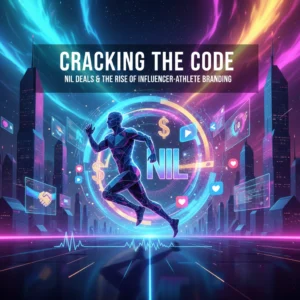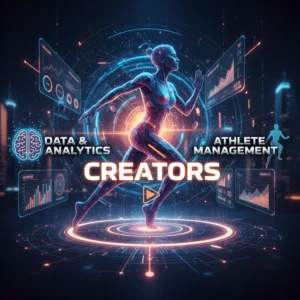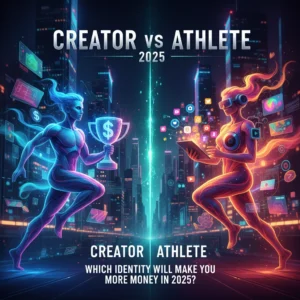Logan Paul to MrBeast: Why Content Creators Are Earning 10x More as Professional Athletes

The numbers are staggering. MrBeast pulls in $85 million annually with a net worth hovering between $500 million and $1 billion. Logan Paul has built a $150 million empire. Meanwhile, the highest-paid NFL player, Aaron Rodgers, makes $50 million per year. Even LeBron James, arguably the most marketable athlete alive, earns around $80 million annually from all sources combined.
So what's happening here? How are content creators consistently out-earning the world's most elite athletes? The answer isn't just about audience size: it's about a fundamental shift in how modern entertainment empires are built.
The Traditional Athlete Revenue Trap
Traditional athletes are locked into a model that hasn't evolved much since the 1980s. Their primary income comes from:
- Team salaries (capped by league structures)
- Endorsement deals (controlled by agencies and brands)
- Appearance fees (limited by time and geography)
This model has a ceiling. Even if you're the best basketball player on the planet, your team salary is still bound by salary caps. Your endorsement deals depend on brand budgets and contract negotiations that can take months or years to finalize.

Content creators flipped this entire system on its head. Instead of waiting for brands to come to them, they became the brands themselves.
The Creator Revenue Revolution
MrBeast didn't just build an audience: he built an ecosystem. His revenue streams include:
- YouTube ad revenue from 200+ million subscribers
- Beast Burger restaurant chain
- Feastables chocolate brand
- Sponsorship deals worth $1-2 million for 10-20 seconds of video placement
- Merchandise lines
- Licensing deals
Logan Paul followed a similar playbook. Beyond his YouTube channels, he's generating massive revenue through:
- Prime Hydration brand (his energy drink company)
- WWE performance contracts
- Podcast network monetization
- Merchandise and NFT collections
- Speaking engagements and live events
The key difference? Creators own their revenue streams. When MrBeast launches Feastables, he's not splitting profits with a team owner or league. When Logan Paul sells Prime Hydration, those margins go directly to his business empire.
Audience Ownership vs. Fan Base Rental
Here's where it gets really interesting. Athletes essentially "rent" their fan base through their teams and leagues. When Tom Brady was with the Patriots, his marketability was tied to that organization. When he moved to Tampa Bay, he had to rebuild local market appeal.
Content creators own their audiences outright. MrBeast's 200 million YouTube subscribers follow him, not a platform or organization. This direct relationship creates unprecedented monetization opportunities.

The scalability is infinite. A single MrBeast video can generate more revenue than an entire NFL season for some players. His Squid Game recreation video cost over $3 million to produce, but the sponsorship deals likely covered the entire production budget before it even went live.
The Diversification Advantage
Traditional athletes put most of their earning potential into one basket: their athletic performance. Injury, age, or a bad season can devastate their income overnight.
Smart content creators spread their risk across multiple revenue streams. Jeffree Star exemplifies this approach perfectly:
- YouTube content: $15-20 million annually
- Jeffree Star Cosmetics: $100 million yearly
- Merchandise and collaborations: Additional millions
Even if his YouTube performance declined, his cosmetics empire continues generating massive revenue independently.
The Geographic Liberation
Athletes are geographically limited. Even global superstars like Messi or Cristiano Ronaldo can only be in one place at a time, limiting their earning opportunities to specific markets and time zones.
Content creators have global reach 24/7. MrBeast's content generates revenue in every time zone simultaneously. His business empire operates while he sleeps, with automated systems handling international sales, licensing deals, and partnership agreements.

Building Media Empires, Not Just Careers
The most successful content creators think like media moguls, not performers. They've evolved beyond personal brand building into systematic business empire construction.
Rhett & Link transformed their Good Mythical Morning show into a full production company. Mark Rober combines his engineering expertise with his YouTube fame to build a STEM subscription business generating $25 million annually.
These creators understand something traditional athletes often miss: personal brand is just the foundation. The real wealth comes from leveraging that brand to build sustainable business systems.
The Sports Management Opportunity
This shift creates massive opportunities for sports management companies that understand the new landscape. Traditional athlete representation focuses on contract negotiations and endorsement deals.
The future belongs to management companies that can help athletes build creator-style business empires. This means:
- Content strategy development beyond social media posting
- Product line creation and management
- Direct-to-consumer brand building
- Multi-platform revenue optimization
- Intellectual property development
The Compound Effect
Perhaps the most important advantage content creators have is compound growth. Every piece of content they create becomes a long-term asset. MrBeast's videos from three years ago are still generating revenue today through views, merchandise sales, and brand awareness.
Traditional athletes see their earning potential peak and decline with their physical performance. Content creators can build momentum that accelerates over time, with each successful venture providing resources and credibility for the next one.

The Integration Model
The smartest athletes are already recognizing this shift. They're not just building social media followings: they're creating content empires alongside their athletic careers.
This hybrid approach: combining athletic excellence with creator business models: represents the future of sports entertainment. Athletes who master both domains will likely become the first billion-dollar sports personalities.
The Bottom Line
Content creators are earning 10x more than professional athletes because they've fundamentally reimagined how entertainment value translates to financial value. Instead of being employees in someone else's system, they've become the system.
They own their audiences, control their revenue streams, and build businesses that scale globally without geographic or time limitations. Most importantly, they've learned to think like entrepreneurs first and performers second.
For athletes, sports management companies, and anyone in the sports industry, the message is clear: the future belongs to those who can blend athletic excellence with creator economy principles. The question isn't whether this trend will continue: it's whether traditional sports will evolve fast enough to keep up.
The creator economy has shown us what's possible when talented individuals take full control of their earning potential. Now it's time for the sports world to take notes.






